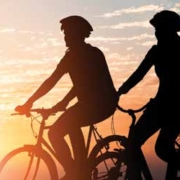What’s The Deal with All These E-Bikes?
by Michelle Avola-Brown, Executive Director, Naples Pathways Coalition
 There is a lot of discussion about electric bikes and where they should be allowed, as well as much confusion regarding the different types of electric devices people are riding. As the executive director of Naples Pathways Coalition, I am often asked to weigh in.
There is a lot of discussion about electric bikes and where they should be allowed, as well as much confusion regarding the different types of electric devices people are riding. As the executive director of Naples Pathways Coalition, I am often asked to weigh in.
I am on the Policy and Programs sub-group of FDOT’s Pedestrian and Bicycle Safety Coalition. The debate around electric devices is happening all over the state, not just in Collier County. Because of that, our group has been researching and reviewing what is and is not working in other parts of the country and Florida, reviewing data related to where serious crashes are happening, and developing educational materials.
The bikes that are becoming more common but difficult to categorize are e-bikes with souped up engines or those whose users have added motors or engines to regular bikes. These devices require no pedaling assistance by the rider like Class 2 e-bikes, but they often go much faster than the 20 mph max available on commercially sold Class 2 e-bikes. The Naples Pathways Coalition Board of Directors and I refer to these bikes as “throttle bikes” and feel they should be categorized as a type of motorcycle. As such, we want education and licensing to become mandatory for bikes requiring no pedaling.
We often see commuter cyclists riding these “throttle bikes.” Honestly, it’s for good reason. Many of these individuals are traveling 20 or 30 miles one way to get to low paying, labor intensive service industry jobs. Statistically, these hard-working individuals are also those who are most frequently injured or killed in crashes with automobiles. With them often wearing dark uniforms, having never had a driver’s license, and riding long distances before the sun comes up or long after it sets, both roads and sidewalks are dangerous places for them to ride.
Some people tell me they want to ban all electric bicycles from sidewalks. However, after we talk and consider the type of bike they have had conflicts with (or, more often, are perceiving conflicts with), the “throttle bikes” are the issue. Despite the overcrowding of our sidewalks, there are relatively few crashes between “throttle bikes” and pedestrians or other bicycle riders, although anyone zipping by unexpectedly can be extremely startling. Automobile drivers are the biggest threat to any pedestrian or cyclist, with the greatest likelihood of causing severe injuries or deaths.
Until Collier County has a safe transportation network for people who bike and walk, pushing electric bicycles onto our roadways would be irresponsible and dangerous. Education is vital, and Naples Pathways wants to work with more employers to provide instruction for commuter cyclists. (We currently work with many restaurants and hotels to provide bike lights, helmets, and safety instruction for their bike commuters. Please contact Michelle@NaplesPathways.org if you own or manage a business and would like us to assist your employees who bike to work.)
No matter the type of bike, riders need to understand that they must slow down to pass people who are walking or biking. They must ride slower on any sidewalk where others are present and use extreme caution when crossing a driveway or parking lot entrance. Cyclists are also required by law to use front and rear lights on their bikes between dusk and dawn, the same as automobile drivers, both to see and be seen.
The sooner the Paradise Coast Trail is completed, with more multi use pathways connecting to it, the sooner everyone can safely get where they are going. The Paradise Coast Trail will be a nearly 80 mile paved, 12 foot wide multi use pathway system separated from the road. It will connect Naples to Bonita Springs, Marco
Island, Collier Seminole State Park, Ave Maria, and Immokalee. The Paradise Coast Trail will also become part of the Florida Gulf Coast Trail, which will extend 420 miles from Collier through Hillsborough counties and the Collier to Polk Trail that will go up the middle of the state.
Having ridden on numerous trails in Florida, Pennsylvania, and Illinois, I have experienced first hand that 12 foot wide pathways can accommodate people who walk, run, stroll with their dogs or children, and ride regular and electric bikes. Sidewalks are too narrow to accommodate all the people who need to use them,
but our roads are too dangerous to force bike riders onto them. Although bicycles have the same rights and responsibilities as cars when using the road, we are much more vulnerable there because we don’t have thousands of pounds of steel around us.
On average, nine people die every day on Florida roads, and six of these tragic deaths are attributed to distracted driving. To make matters worse, Florida drivers kill more cyclists and more pedestrians than any other state.
To learn more about the Paradise Coast Trail, please visit www.NaplesPathways.org/PCTrail.
To help us in our mission to create a safe, bikeable and walkable community, please become a member at www.NaplesPathways.org/Join.

Michelle Avola
Ex Director of NPC
To volunteer and become part of the solution, or if you have questions or suggestions, please email me at Michelle@NaplesPathways.org




Leave a Reply
Want to join the discussion?Feel free to contribute!